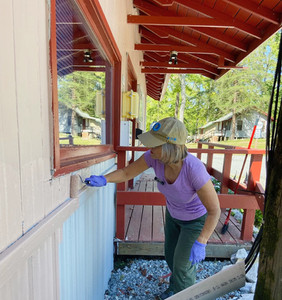Working at Sandy Cove Ministries
- uniquejt
- Sep 16, 2023
- 2 min read

Sunday we rested and recovered from a very long day's baseball game adventure to Washington, D.C. We went to church with our team leaders and then out to breakfast before returning back to camp. We just hung out and relaxed while reading and napping. We received some unfortunate news over the weekend about the rest of our team. Our third couple, Jeff and Kathy, had to cancel due to health issues so we will finish the project with our team of four for the duration. Fortunately, Melissa, Frank, Karen and I all work together well and are developing a deep friendship in the process.

This is our second week at our RVICS project. The women have been working with the kitchen staff cleaning and helping with meal preparation. The men have been doing exterior painting on a cabin and just finished prepping a new building to be painted. This new structure is where the camp store is located and it's a much larger building. We worked through the week separately until Thursday, September 14 when the ladies joined us on the painting project. Thanks to their help we were able to complete painting the first coat on the entire building. The work days left us all pretty exhausted, but we did manage to get in a Bible study on Tuesday, and a game of 4 Up, 4 Down on Wednesday evening. Thank God for power naps after lunch!
On Friday, September 15 we had the day off and used it to visit the surrounding area. We drove into nearby Havre de Grace, Maryland to tour their Decoy Museum. Fun fact: this Maryland City is known as the Decoy Capital of the World. Havre de Grace in Harford County houses one of the finest collections of working and decorative Chesapeake Bay decoys ever assembled.
Located on the banks of the historic Susquehanna Flats, the Havre de Grace Decoy Museum was established in 1986 as a private, non-profit institution existing to preserve the historical and cultural legacy of waterfowling and decoy making on the Chesapeake Bay.

I had no idea how much went into making a working decoy. The exhibit was a fascinating display of artistry and craftsmanship. There many different types of waterfowl on display.


The case below had a muzzleloader, percussion fowler, 7-gauge shotgun circa 1835.

The photo below is a sinkbox, a specialized hunting blind used by waterfowl hunters. It consists of a weighted, partially submerged enclosure large enough to hold one or more hunters and suspended from a floating platform. It is placed into calm water so that the hunter may wait with the waterline at approximately shoulder height. By 1839, New York prohibited the use of sink boxes. From 1852 to 1897, other states such as Ohio, Michigan, Illinois, and New Jersey banned their use as well. Eventually they were outlawed in all of the United States under federal law.

After our tour of the museum we had a seafood lunch at the Promenade Grill then walked off our meal strolling the Havre de Grace Promenade to the lighthouse park and back before driving back to the camp



























Comments